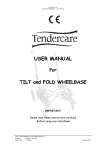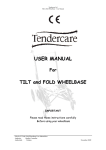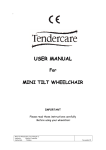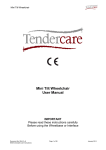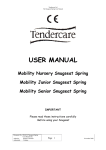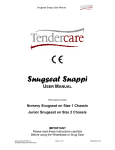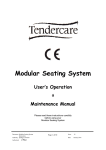Download User Manual - Tendercare Ltd
Transcript
USER MANUAL For TILT and FOLD WHEELCHAIR – GAS STRUT MODEL IMPORTANT Please read these instructions carefully Before using your wheelchair Please read Page 8 before using the Tilt in Space facility Tilt & Fold User Manual – Gas Strut Model v4 Authority. Quality Controller Authorised. J Adams January 2011 Headrest Armrest Push Handle Backrest Lock Footrest Seat Tilt Lock Tipping Lever Brake Lever Gas Strut Operating Lever TENDERCARE TILT & FOLD WHEELCHAIR Tilt & Fold User Manual – Gas Strut Model v4 Authority. Quality Controller Authorised by, J Adams Page 2 of 23 January 2011 Tendercare Ltd Tilt & Fold User Manual – Gas Strut Model CONTENTS ITEM DESCRIPTION PAGE 1 Who to contact if you have difficulty………………………………. 4 2 Intended user………………………………………………………… 4 3 Unpacking……………………………………………………………. 4 4 Preparing for use…………………………………………………….. 5 4.1 Unfolding and assembling the wheelchair……………………….. 4.2 Fitting and removing footrests…………………………………… 4.3 Fitting and removing headrest……………………………………. 4.4 Tilt in Space……………………………………………………… 4.5 Tyres and Brakes…………………………………………………. 4.6 Rear Wheel Position……………………………………………… 4.7 Self Propelling Wheels…………………………………………… 4.8 Tipping Wheelchair………………………………………………. 4.9 Thoracic Backboard……………………………………………… 4.10 Play Tray………………………………………………………… 5 6 7 8 8/9 9/10 10 11 12 13 User instructions…………………………………………………….. 16 5.1 Getting into the wheelchair………………………………………. 5.2 Getting out of the wheelchair…………………………………….. 5.3 Sideways transfer………………………………………………… 16 16 16 Attendant Pushing…………………………………………………… 17 5 6 6.1 6.2 6.2 6.4 Pushing…………………………………………………………… Brakes…………………………………………………………….. Comfort…………………………………………………………... Lifting and general safety………………………………………... 17 17/18 18 18 7 Cleaning……………………………………………………………… 18 8 Maintenance…………………………………………………………. 19 8.1 Routine maintenance…………………………………………….. 8.2 Six monthly maintenance………………………………………… 19 19 9 Oxygen cylinder……………………………………………………… 20 10 Warranty……………………………………………………………... 20 11 Transporting the wheelchair………………………………………... 21/22 12 Repairs……………………………………………………………….. 23 Tilt & Fold User Manual – Gas Strut Model v4 Authority. Quality Controller Authorised by, J Adams Page 3 of 23 January 2011 Tendercare Ltd Tilt & Fold User Manual – Gas Strut Model 1. Who to contact in difficulty Tendercare Ltd PO Box 3091, Littlehampton, BN16 2WF Tel (01903) 726161 Fax (01903) 734083 Email: [email protected] 2. Intended user The wheelchair has been designed for older children and adults who will benefit from a tilt in space facility. It is also suitable for carrying special seating systems for all children who require postural management. It has four wheels the front wheels are castors to allow easy steering. The frame can be folded for transit and has tilt in space seating. The armrests lift off for easy side transfer and the push handles are adjustable in height to suit a wide range of attendants. The maximum user weight including any inserts should not exceed 114.5kg (18 stone). 3. Unpacking The wheelchair is delivered in a cardboard carton approximate weight 28 kg and size 800 mm wide x 350 mm deep x 870 mm high. Warning the transit carton is heavy so moving and unpacking must be done with care. Observe all lifting and handling regulations. 1) Stand the Carton upright making sure it is supported and cannot fall over. Open the carton and remove any packages or packing, which could obstruct the removal of the frame. 2) Carefully pull out the wheelchair and check that you have the following items:Item 1. 2. 3. 4. 5. 6. 7. 8. 9. Component Tilt and Fold wheelchair Armrests Push handles Thumb screws (for push handles) Footrests Headrest support rods Fabric headrest support Headrest cushion User Manual Number Yes No 1 2 2 4 2 2 1 1 1 If any items are damaged or missing please contact Tendercare, Preferably by fax 01903-734083 within 36 hours of delivery. 3) After unpacking and checking you have all components and that they are in good condition, carefully dispose of the packaging at your local recycling centre. Tilt & Fold User Manual – Gas Strut Model v4 Authority. Quality Controller Authorised by, J Adams Page 4 of 23 January 2011 Tendercare Ltd Tilt & Fold User Manual – Gas Strut Model 4. Preparing for use and operation Warning: - When opening or folding the wheelchair, ensure that you hold the frame so that you avoid any danger of catching your fingers in moving parts. - Keep children clear of the wheelbase during opening and folding. 4.1 Unfolding and assembling the wheelchair 1) Carefully lift the wheelchair upright. 2) Backrest supports. Standing behind the wheelchair lift the two-backrest locking pins using the ball shaped handgrips at the bottom of the backrest tubes. Turn them so that they lock into the groove arrowed opposite. Lift backrest supports vertical. Lock the supports in position by moving the handgrips out of the arrowed groove (see photo) and make sure they move to the bottom of the slot in the backrest tube. 3) Push handles. The push handles are fitted to the wheelchair when it is delivered. To adjust the height to suit you, simply unscrew (turn anti clockwise) the two thumbscrews at either side and near the top of the backrest. (See photo opposite) Lift or lower the push handles to a height that suits you then retighten (turn clockwise) the thumbscrews. To prevent the push handles moving in use these screws must be tight. You should regularly check that they are tightened properly. To make it easier for some people to push the wheelchair when the backrest is in its lowest position the push handles can be reversed so that the handgrips are pointing forwards. Simply unscrew the thumbscrews, turn the push handles so they are pointing forwards and refit the thumbscrews. Note:- when the handgrips are in this position the headrest cannot be used. 4) Unfolding the seat. Standing in front of the wheelchair place palms of hands on each side of the seat then press down to open the wheelchair. Take care to hold your fingers towards the centre of the seat to avoid catching them on the wheelchair frame. Tilt & Fold User Manual – Gas Strut Model v4 Authority. Quality Controller Authorised by, J Adams Page 5 of 23 January 2011 Tendercare Ltd Tilt & Fold User Manual – Gas Strut Model 5) Backrest spreader bar. Standing behind wheelchair lift the chrome “spreader” bar, which is on the right hand backrest support, upwards and place its slotted end onto the peg on the left hand backrest support (arrowed). It may be necessary to push the backrest supports apart when doing this. 6) Armrests. Standing at the side of the wheelchair place each armrest into the holes in the wheelchair frame. (See photo). Make sure they are pressed into the wheelchair frame properly. Make sure that the tube supporting the armpad extends to the rear of the wheelchair. Armrests must be removed for transportation. 4.2 Fitting and removing footrests 1) Fitting the footrests. To fit the right hand footrest, stand in front of the wheelchair. Remove the spring clip from the lower hinge pin on the side of the wheelchair. Making sure the footplate is facing in towards the centre of the wheelchair place the footrest onto the hinge pins. (See Photo opposite). Replace the spring clip. Swing the footrest towards the centre of the wheelchair until it locks in place. Repeat for the left hand footrest. Hinge Pins Adjust the height of the footrest by loosening the nut on the support tube using a 10 mm spanner. Move the footrest to the desired height then retighten the clamp nut. (See picture opposite). The angle of the footplate can be adjusted by loosening the lock nut, which is at the bottom of the footplate support tube. Screw in or out the footplate stop; until the desired angle is obtained then retighten the lock nut. Tilt & Fold User Manual – Gas Strut Model v4 Authority. Quality Controller Authorised by, J Adams Page 6 of 23 January 2011 Tendercare Ltd Tilt & Fold User Manual – Gas Strut Model 2) To fold footrests back against the wheelchair frame. Lift up the footplate so that it is vertical then push on the silver catch on the footrest. The Footrest will then swing back. (See picture opposite). To return the footrest ready for use simply swing the footrest forwards until the catch locks then lower the footplate. 3) To remove footrests. Remove the spring clip from the lower hinge pin. Swing the footrest to the side and holding the curved part of the support tube lift upwards. Tip: - The spring clip prevents the footrests being lost. However, if you need to regularly remove the footrests the spring clip can be discarded. 4.3 Fitting and Removing Headrest Place the headrest support tubes into the top of the backrest tubes just in front of the push handles (see photo opposite). A Fit the headrest upholstery (A) over the two support rods. Attach the headrest cushion (B) using the Velcro strips. B Reverse the above to remove the headrest Tilt & Fold User Manual – Gas Strut Model v4 Authority. Quality Controller Authorised by, J Adams Page 7 of 23 January 2011 Tendercare Ltd Tilt & Fold User Manual – Gas Strut Model 4.4 Tilt in Space The angle of the seat and backrest can be adjusted to any angle between the upright and fully reclined position. To recline the seat, put the brakes on and stand behind the wheelchair. Holding both push handles squeeze the operating lever (see photo opposite) and push down evenly on both handles. Release the lever when the seat is at the desired angle. To bring the seat upright put the brakes on and stand behind the wheelchair. Holding both push handles squeeze the operating lever (see photo opposite) and lift evenly on both handles. Release the lever when the seat is at the desired angle. OPERATING LEVER Important: - Always put the brakes on and move both push handles together when adjusting the seat angle. 4.5 Tyres and Brakes The tyres are made from a solid material and do not require any attention other than being cleaned with a damp cloth when dirty. Check brakes by moving both levers forward as far as they will go. The wheels should now be locked. If the wheels move the brakes need adjusting. Left and Right Handed Occupant brakes are fitted as standard to all Tilt & Fold Wheelchairs. If the wheelchair is fitted with (optional) Hub Brake wheels the standard Occupant brake will also be fitted. Hub brakes are for the attendants use only and not for use as a parking brake. You must ensure that the supplied Occupant parking brakes are used when the chair needs to be parked and you must not rely on any parking brake which may be fitted to the Hub Brakes. Always put both brakes on when the occupant is getting in or out of the wheelchair. Tilt & Fold User Manual – Gas Strut Model v4 Authority. Quality Controller Authorised by, J Adams Page 8 of 23 January 2011 Tendercare Ltd Tilt & Fold User Manual – Gas Strut Model Adjust the brakes by loosening the nut (arrowed) locking the brake pad in place. Turn the brake pad so that it is near to, but not touching, the tyre. Retighten the locking nut. Always adjust both brakes at the same time and recheck that the brakes work properly. Note: Don’t leave the brakes ON for a long period. If you do a flat section may appear on the tyre. When not using the wheelchair i.e. overnight or during storage make sure the brakes are OFF. 4.6 Rear Wheel Position The rear wheel is supplied mounted in its forward position to provide optimum ease of manoeuvring and tipping. However, a small number of people may require a greater degree of stability. If this is the case the rear wheel and brake can be moved to its rear mounting. It is recommended that this is only done by a technician or competent DIY person. Using two 19mm spanners undo the axle mounting nut. Make sure you note the position of the various washers. Move the wheel to the rear hole refit the washers, apply Loctite to the threads refit the nut and tighten. (See picture opposite). To move the brake assembly use a 3 mm hexagon key and 8 mm spanner to remove the rear brake linkage screw making a note of the position of the spacers. (See photograph below). Using a 4 mm hexagon key remove the two back-plate retaining screws and move the plate back so that its fixing screws fit the into the two rear holes on the wheelchair frame. Refit the screws making sure that the washer and spacer is correctly positioned. (See Photographs on page 10). Tilt & Fold User Manual – Gas Strut Model v4 Authority. Quality Controller Authorised by, J Adams Page 9 of 23 January 2011 Tendercare Ltd Tilt & Fold User Manual – Gas Strut Model Fixing Screw Washer Spacer Adjust the brakes as described in section 4.5 above. 4.7 Self Propelling Wheels Propelling wheels are normally supplied pre-fitted but they can also be fitted later as an optional extra. It is recommended that a technician or competent DIY person only does this. Wheel Axle Mounting Boss Bracket Bracket Fixing Nuts and Bolts Wheel Axle Mounting Quick Release Wheel Axle Remove the rear wheels and brakes as described in section 4.6 above. Fit the bracket to the wheelchair using the holes shown on the photograph opposite. The bracket must be fitted with the shorter side at the top and the longer side in the vertical position. The wheel axle mounting boss must be facing in towards. Attach the bracket to the wheelchair by inserting the bolts from the outside of the wheelchair. Apply Loctite to the bolt threads, fit the nuts and tighten using 19 mm spanners. Tilt & Fold User Manual – Gas Strut Model v4 Authority. Quality Controller Authorised by, J Adams Page 10 of 23 January 2011 Tendercare Ltd Tilt & Fold User Manual – Gas Strut Model Insert the wheel axle mounting from the outside of the bracket, apply Loctite to the thread then fit and tighten the nut using a 22 mm spanner on the outside and 24 mm spanner on the inside. Press the button on the end of the quick release wheel axle and insert it into the centre of the wheel then into the wheel axle mounting on the wheelchair. To remove the wheel press the button on the end of the quick release wheel axle and pull the wheel from the wheelchair. Refit the brakes using the holes in the brake mounting plate shown in the photograph opposite. Attach the brake assembly to the wheelchair using the two front holes in the wheelchair frame. (See below). Reassemble, adjust and test the brakes as described in sections 4.5 and 4.6 above. 4.8 Tipping the Wheelchair To tip the wheelchair backwards when climbing kerbs stand behind the wheelchair holding onto both push handles. Place one foot, either the right or left, whichever suits you, onto the tipping lever as shown in the picture opposite. Press down with your foot and pull back with your arms. The front of the chair will lift. IMPORTANT: - Take great care when doing this to avoid the combined weight of the wheelchair and occupant overcoming your strength and tipping back onto you. Never try to tip the wheelchair if the occupant is much heavier than you are. Tilt & Fold User Manual – Gas Strut Model v4 Authority. Quality Controller Authorised by, J Adams Page 11 of 23 January 2011 Tendercare Ltd Tilt & Fold User Manual – Gas Strut Model 4.9 Thoracic Backboard (optional) The Tilt and Fold can be supplied with an optional thoracic backboard and lateral supports. This attaches to the wheelchair using 2 red straps fitted with click fit buckles. Thoracic Backboard Mounting Straps (Red) To fit the backboard to the chair, loosen off the strap so that it comfortably wraps around the back of the chair. Make sure the straps go around the outsides of the wheelchairs backrest tubes. Clip the two halves of the buckle together as shown. Next pull the free end of the webbing to tighten the strap. Ensure that the strap is straight and sufficiently tightened so that the backboard is secure. Also check that the strap is going around the tubes and is not interfering with any of the fixings on the back of the chair. Left: The backboard correctly fitted to the back of the chair. IMPORTANT: The red straps must be fitted as detailed here. They are to secure the backboard to the wheelchair and they are not part of the patient harnessing. They must not be used as a restraint for the occupant of the wheelchair. Tilt & Fold User Manual – Gas Strut Model v4 Authority. Quality Controller Authorised by, J Adams Page 12 of 23 January 2011 Tendercare Ltd Tilt & Fold User Manual – Gas Strut Model 4.10 Playtray The playtray offers height, depth and angle adjustment, so that it can be adapted to suit your needs. A number of different playtrays are available for the Tilt and Fold. The black playtray has been used for illustration purposes. The playtray comes supplied with the following: • 2 vertical stems (fitted to the tray) • 2 depth adjustment brackets and thumbscrews (fitted to the tray) • 2 height and angle adjustment brackets (fitted to the armrests) Fig 4.10.1 To fit the play tray to the seat, locate the 2 vertical stems on the bottom of the tray into the 2 receivers on the armrests. It may be necessary to loosen the thumbscrews in the armrest bracket to allow the vertical stems to drop through. Adjust the height of the play tray to the desired position, then secure by tightening the 2 thumbscrews as shown (left). Fig 4.10.2 To adjust the angle of the playtray, loosen the 2 angle adjustors using a 5mm hexagon key as shown (right). Move the playtray to the desired angle, and then retighten the locking screws. Fig 4.10.3 Tilt & Fold User Manual – Gas Strut Model v4 Authority. Quality Controller Authorised by, J Adams Page 13 of 23 January 2011 Tendercare Ltd Tilt & Fold User Manual – Gas Strut Model To adjust the depth of the playtray, loosen the 2 thumbscrews under the base of the tray as shown (left). Slide the tray in or out to the required depth, and then retighten the screws. Fig 4.10.4 IMPORTANT: • When adjusting the Tilt In Space facility, the angle of the playtray must be adjusted to the new horizontal position (see above instructions for how to adjust the angle of the tray). • All items must be removed from the playtray before making any adjustment to the tray or wheelchair to avoid the risk of causing accidental harm to the occupant. • The playtray must be removed before folding the wheelchair. • The playtray must be removed when transporting the wheelchair in specially adapted vehicles. • Never leave the occupant unattended with the playtray fitted, especially when items are positioned on the tray. • Extra care must be taken when placing food or drink on the tray. • Maximum carrying capacity of the play tray is 5kg. Tilt & Fold User Manual – Gas Strut Model v4 Authority. Quality Controller Authorised by, J Adams Page 14 of 23 January 2011 Tendercare Ltd Tilt & Fold User Manual – Gas Strut Model If the playtray is ordered separately from the wheelchair, the armrest brackets will not have been fitted. In this case, 2 armrest brackets and 2 fixing screws will be supplied with the playtray and must be fitted to the armrests as detailed below: To fit the playtray receiver brackets: First remove the existing screw from ‘D’ using a crosshead screwdriver. Next remove the plastic cap ‘C’ by levering it off using a small flat bladed screwdriver. Fig 4.10.5 Push the armrest bracket ‘A’ over the end of the armrest frame, with the large hole to the bottom, and the thumbwheel to the outside of the armrest. Fig 4.10.6 Secure the bracket in place by screwing the fixing screw ‘B’ through the bracket and frame and into the armrest pad (through fixing point ‘D’) as shown (right). Fig 4.10.7 Tilt & Fold User Manual – Gas Strut Model v4 Authority. Quality Controller Authorised by, J Adams Page 15 of 23 January 2011 Tendercare Ltd Tilt & Fold User Manual – Gas Strut Model 5. User Instructions 5.1 Getting into the wheelchair 1) 2) 3) 4) Put the brakes on. Lift the footplates and swing aside. Lower yourself onto the seat using the armrests for support. Swing footrest back into place and rest your feet on them. 5.2 Getting out of the wheelchair 1) 2) 3) 4) Put the brakes on. Lift footrests and swing aside. Place arms on armrests. Slowly push yourself up to a standing position. 5.3 Sideways Transfer 1) 2) 3) 4) 5) Put the brakes on. Lift footplates and swing them aside and put feet on the ground. Lift off armrest on the side you are transferring from. Place transfer board from the wheelchair seat to the easy chair, bed etc. Slide across the board whilst leaning slightly forwards and taking care not to move the wheelchair or transfer board Tilt & Fold User Manual – Gas Strut Model v4 Authority. Quality Controller Authorised by, J Adams Page 16 of 23 January 2011 Tendercare Ltd Tilt & Fold User Manual – Gas Strut Model 6. Attendant Pushing 6.1 Pushing 1) The wheelchair is easy to push over hard, even surfaces but may be more difficult over rough; uneven surfaces and the wheels may sink into soft ground. Never force the wheelchair if it becomes stuck, this may cause the rear wheels to lift and the user may be tipped out of the chair. If the chair gets jammed on a stone or cracked pavement, tip the wheelchair backwards using the tipping levers to raise the castors over the obstacle and then proceed. On soft ground it may be easier to pull the wheelchair backwards. 2) Whenever possible avoid steep and uneven surfaces because there is a danger that the wheelchair may tip over. If you cannot avoid difficult surfaces you must take extra care when travelling across them. 3) Do not use the wheelchair in sandy conditions. 4) Always use two hands for pushing the wheelchair. 5) The wheelchair is steered by the front castors. Most pavements slope slightly towards the kerb and the chair will have a tendency to curve in the downward direction towards the road. Two hands will be needed to prevent this. 6) For the comfort of the occupant always avoid pushing too fast or making sudden fast turns, jerking, jolting or bumping. Many occupants are liable to be affected by rough handling, which can cause loss of confidence, discomfort or pain. 7) Avoid kerbs. Wherever possible use ramped kerbs or slopes. This will make pushing the chair easier and safer and will be more comfortable for the occupant. 8) Avoid steep kerbs and flights of steps because of the danger of losing your grip on the chair or of the occupant being tipped out. Always use a ramp or lift if available. 9) Always look well ahead so that you have plenty of time to avoid hazards. 10) Be considerate to other people and watch out for pedestrians who may stop or suddenly change direction. 6.2 Brakes 1) Always put the brakes on when getting into or out of the wheelchair and when leaving the occupied wheelchair unattended. 2) To avoid making flat sections on the tyres never store the wheelchair with the brakes on for long periods i.e. overnight or during storage. 3) If the wheelchair is fitted with (optional) Hub Brake wheels the standard Occupant brake will also be fitted. Hub brakes are for the attendants use only and not for use as a parking brake. You must ensure that the supplied Occupant parking brakes are used when the chair Tilt & Fold User Manual – Gas Strut Model v4 Authority. Quality Controller Authorised by, J Adams Page 17 of 23 January 2011 Tendercare Ltd Tilt & Fold User Manual – Gas Strut Model needs to be parked and you must not rely on any parking brake which may be fitted to the Hub Brakes. 4) Always put both brakes on when the occupant is getting in or out of the wheelchair. 6.3 Comfort 1) Always be considerate to the occupant 2) Before setting out on a journey make sure the occupant is comfortably and correctly seated and that any safety straps of harnesses are correctly adjusted and used. Always ensure that both feet are on the footrests and that clothing is tucked in and cannot catch on the wheels. 3) Remember the occupant is in front of you. They will want to be part of your conversations and interests. Also their view will be different to yours when it comes to looking into shop windows, etc. it can be extremely frustrating to hear an exciting bargain being discussed when it is situated somewhere behind the wheelchair occupant’s ear, and thus, out of sight. 6.4 Lifting and general safety 1) The wheelchair is designed to be used by one person only. Never allow children to play on the wheelchair or stand on the footrests or tipping levers. Never hang anything such as bags on the push handles. If you do, there is a danger of the wheelchair tipping backwards. 2) Never try to lift the wheelchair when the user is sitting in it. 3) For your own safety and good practice never lift the empty wheelchair until it has been properly folded and the footrests have been removed. Always use good lifting practice. 4) Never leave the child/occupant unattended, even with the harness fitted. 5) Keep the child clear of the wheelbase during opening and folding. 7. Cleaning 1) Whenever the wheelchair gets dirty it should be cleaned using a damp cloth and then dried thoroughly. 2) For more stubborn stains wipe with a damp cloth using a mild solution of warm water and soap. 3) Never use furniture polish or spirit to clean the frame. 4) The Fabric parts of the Wheelchair are made from Ambla fabric. Ambla is resistant to most mild acids, alkalis, drinks and household stains. Clean with a damp soapy cloth and rinse well with clean water. A soft brush can be used for heavy soiling. Do not use solvents, bleaches, abrasives, synthetic detergents, wax polishes or aerosol sprays. Tilt & Fold User Manual – Gas Strut Model v4 Authority. Quality Controller Authorised by, J Adams Page 18 of 23 January 2011 Tendercare Ltd Tilt & Fold User Manual – Gas Strut Model 8. Maintenance 8.1 Routine maintenance The user or their family can easily carry out the following tasks. No tools are required. 1) Always wipe the wheelchair dry. Never put it away damp. 2) Check all four-push handle retaining knobs are in place and are hand tight (daily). 3) Check brake operation (weekly). 4) Check operation of Tilt and Fold mechanism (weekly). 5) Clean frame when necessary (we suggest at least once a week). 8.2 Six monthly maintenance Someone who is a competent tradesman or repairer should only carry out this work. If a major fault is found stop using the wheelchair until it has been corrected. 1) Fold and open the wheelchair. Check that all movements through the folding range are free. Examine frame for any damage. 2) Examine upholstery for wear and arrange for replacement if necessary. 3) Examine nuts, bolts, pivots, sliders and frame plugs for tightness and general condition. 4) Examine push handle retaining knobs and check they are hand tight. 5) Examine heel loops for damage or excessive wear and that the retaining nuts are tight. 6) Examine brake assemblies for wear, damage and adjustment. 7) Examine Tilt and Fold mechanism and check operation of reclining mechanism. 8) Examine front castors for free rotation and check castor assembly to wheelchair. Check rear wheels for free rotation and check rear wheel fixing to wheelchair. For all other repairs refer to your issuing authority or Tendercare Ltd. Tilt & Fold User Manual – Gas Strut Model v4 Authority. Quality Controller Authorised by, J Adams Page 19 of 23 January 2011 Tendercare Ltd Tilt & Fold User Manual – Gas Strut Model 9. Oxygen Cylinder If a portable oxygen cylinder is required, the maximum size recommended by Tendercare for use with the wheelchair is type PD 455 mm long x 100 mm diameter weight approximately 10 kg. For cylinder and safety information contact:BOC Gases, Customer Service Centre, Priestley Road, Worsley, Manchester M28 2UT. Telephone 0800 111 333. Warnings:If using medical oxygen cylinders ensure compliance with applicable regulations. When mounting an oxygen cylinder onto the wheelchair care must be taken to ensure the wheelchair will not be damaged in any way. In addition the stability of the wheelchair must not adversely affected. If necessary, stability tests should be carried out on the loaded wheelchair. If an oxygen cylinder is required it must be mounted in an approved oxygen tray, be adequately supported, preferably in a cradle, and restrained considering the intended wheelchair use and environment. Valve, gauges and fittings must be adequately protected from mechanical damage. When using an oxygen cylinder, users and carers should be aware of the potential hazard caused by smoking, naked flames or other exposed heat sources, oil or grease. Because the fitting and use of oxygen are outside the control of Tendercare Ltd, Tendercare Ltd does not accept any liability relating to the use of oxygen with the wheelchair. 10. Warranty 1) Tendercare undertakes to repair or replace free of charge, any parts or part found to be defective due to manufacturer within a period of 12 months from the date of delivery. 2) Tendercare Limited will not repair or replace free of charge any part or parts found to be defective due to abuse, misuse or lack of correct maintenance. 3) Equipment for warranty claims should be returned in a strong carton. There may be a charge for collection. Contact customer service department on 01903 726161. Tilt & Fold User Manual – Gas Strut Model v4 Authority. Quality Controller Authorised by, J Adams Page 20 of 23 January 2011 Tendercare Ltd Tilt & Fold User Manual – Gas Strut Model 11. Transporting The Tilt and Fold wheelchair can be transported in the luggage boot of a motorcar. The Tilt and Fold wheelchair has been successfully impact tested against International Standard ISO7171-19 and may be used as a vehicle seat. When used as a vehicle seat the following instructions must be followed. • The front of the wheelchair must be facing towards the front of the vehicle. (In the direction of travel). • The seat must be in the most upright or mid tilt position • The armrests must be removed • If a seat cushion is used this must be attached to the wheelchair backrest. (This is necessary to prevent the cushion from moving and allowing the occupant to “submarine” under the seat belt). • The wheelchair has only been tested with the Karabiner 4-Point Webbing Restraint System. No other restraint system can be used. • For occupant safety the brakes should be applied whilst the restraints are attached • A trained person should only attach the restraints. The front restraints should be attached first then the rear restraints attached and tensioned. • If transporting medical oxygen cylinders, ensure compliance with applicable standards. • The restraint location points are marked on the wheelchair with silver labels as shown below. Front Restraint Location Point Restraint attached to inner front frame as Shown. The restraints should be attached so that the quick release buckle is towards to outside of the wheelchair to allow for quick release in an emergency. Tilt & Fold User Manual – Gas Strut Model v4 Authority. Quality Controller Authorised by, J Adams Page 21 of 23 January 2011 Tendercare Ltd Tilt & Fold User Manual – Gas Strut Model Rear Restraint Location Point Karabiner hooked around the backrest tube just above the joint of the backrest with the upper side frame i.e. between the seat and backrest upholstery. (See picture opposite). Important: - In addition to securing the wheelchair the occupant must always be restrained by an approved vehicle belt providing lap and over the shoulder protection. We recommend the Unwin Safety Systems Double Inertia Reel Harness be used. ANY ITEM INVOLVED IN AN ACCIDENT NO MATTER HOW MINOR, MUST BE WITHDRAWN FROM SERVICE IMMEDIATELY AND REPLACED. Alternatively the user may be transferred to an approved vehicle seat and the wheelchair folded and placed safely in the luggage area of the vehicle. Tilt & Fold User Manual – Gas Strut Model v4 Authority. Quality Controller Authorised by, J Adams Page 22 of 23 January 2011 Tendercare Ltd Tilt & Fold User Manual – Gas Strut Model 12. Repairs 1) Repairs; for all repairs contact your issuing authority. 2) Major repairs; for all major repairs e.g. bent or damaged frame, the equipment should be returned to the factory. Contact Tendercare Ltd customer services on 01903 726161. 3) An approved agent may carry out the following repairs and replacements. A workshop manual is available to repairers. Brake adjustment, replacement of front castors; rear wheels, armpads, seat and backrest upholstery, gas struts and interconnecting cables. Important Points 1) 2) 3) 4) Do not reuse Nyloc nuts. Always replace with a new Nyloc nut. Always use Loctite thread locking compound Grade 241. Always use recommended components and parts available from Tendercare Ltd. Do not modify or repair the frame NOTES Tilt & Fold User Manual – Gas Strut Model v4 Authority. Quality Controller Authorised by, J Adams Page 23 of 23 January 2011
























